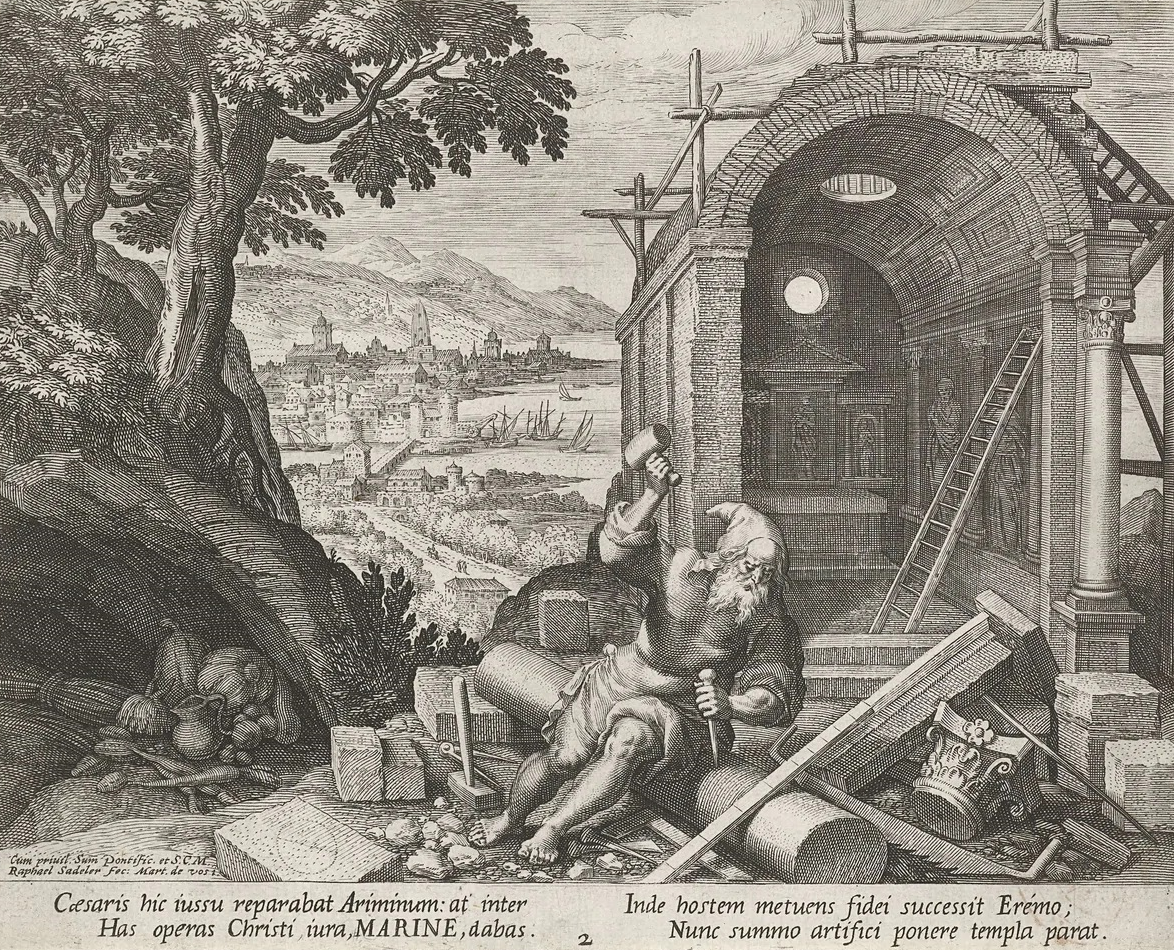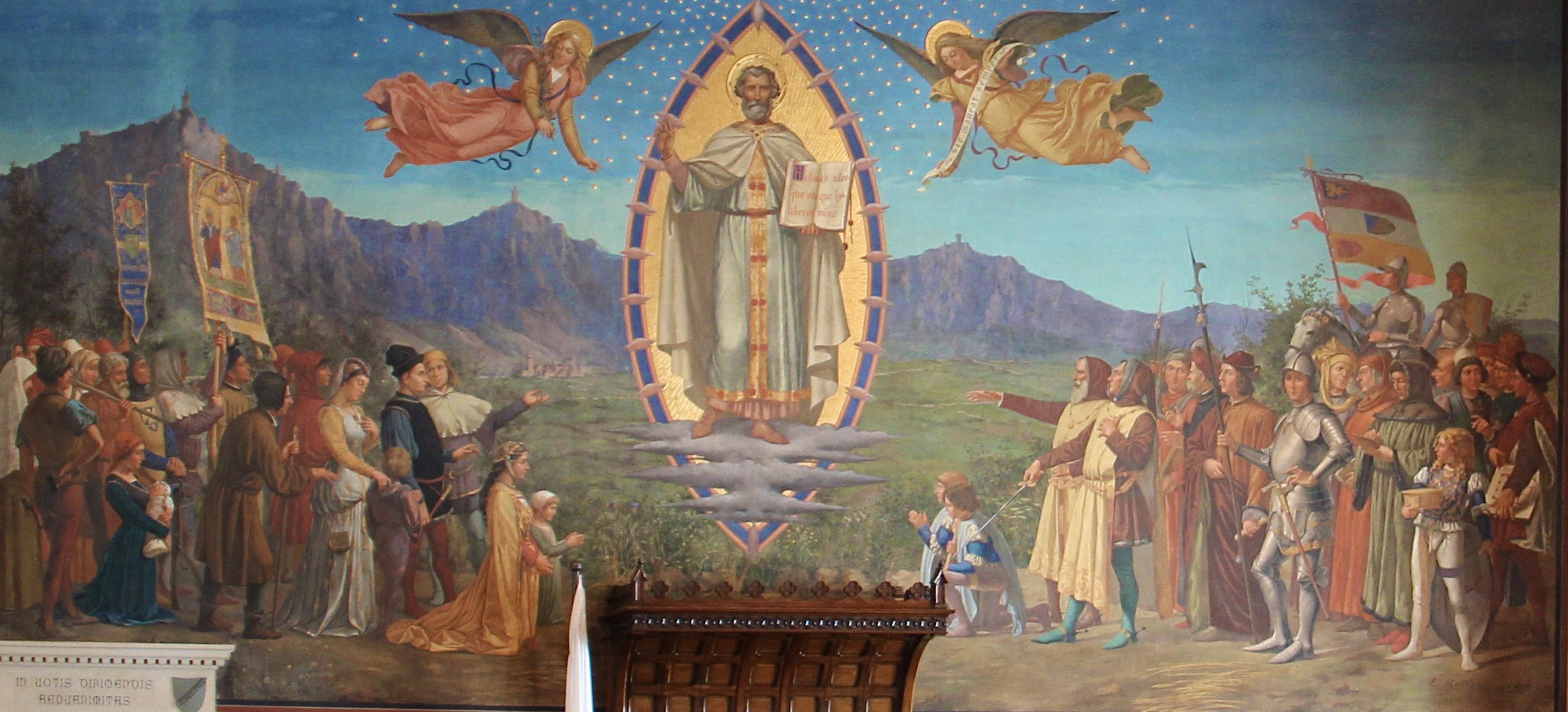Saint Marinus on:
[Wikipedia]
[Google]
[Amazon]
Marinus (; ) was an
 Known only by the single name ''Marinus'' (lit. of the sea), he was ordained a deacon by Gaudentius of Rimini; later, he was recognised and accused by an insane woman of being her estranged husband, so he quickly fled to
Known only by the single name ''Marinus'' (lit. of the sea), he was ordained a deacon by Gaudentius of Rimini; later, he was recognised and accused by an insane woman of being her estranged husband, so he quickly fled to  Marinus was canonised as a saint, and later, the State of San Marino grew up from the centre created by the monastery. His feast day/memorial day is 3 September, commemorating the day, in 301, when he founded what became known as
Marinus was canonised as a saint, and later, the State of San Marino grew up from the centre created by the monastery. His feast day/memorial day is 3 September, commemorating the day, in 301, when he founded what became known as
Link to journal.Link to copy of paper
Patron Saints Index: Saint Marinus
{{DEFAULTSORT:Marinus Sammarinese Roman Catholic saints 3rd-century births 366 deaths History of San Marino People from the City of San Marino 4th-century Romans 4th-century Christian saints Republicans People from Rab Legendary Romans Hermits in the Roman Empire Christian hermits Diocletianic Persecution
Early Christian
Early Christianity, otherwise called the Early Church or Paleo-Christianity, describes the historical era of the Christian religion up to the First Council of Nicaea in 325. Christianity spread from the Levant, across the Roman Empire, and be ...
and the founder of a chapel and monastery in 301 from whose initial community the state of San Marino
San Marino, officially the Republic of San Marino, is a landlocked country in Southern Europe, completely surrounded by Italy. Located on the northeastern slopes of the Apennine Mountains, it is the larger of two European microstates, microsta ...
later grew.
Life
Tradition holds that he was a stonemason by trade who came from the island of Arba (today Rab), on the other side of theAdriatic Sea
The Adriatic Sea () is a body of water separating the Italian Peninsula from the Balkans, Balkan Peninsula. The Adriatic is the northernmost arm of the Mediterranean Sea, extending from the Strait of Otranto (where it connects to the Ionian Se ...
(in what is now part of modern-day Croatia
Croatia, officially the Republic of Croatia, is a country in Central Europe, Central and Southeast Europe, on the coast of the Adriatic Sea. It borders Slovenia to the northwest, Hungary to the northeast, Serbia to the east, Bosnia and Herze ...
, then part of the Roman Empire
The Roman Empire ruled the Mediterranean and much of Europe, Western Asia and North Africa. The Roman people, Romans conquered most of this during the Roman Republic, Republic, and it was ruled by emperors following Octavian's assumption of ...
), fleeing persecution for his Christian
A Christian () is a person who follows or adheres to Christianity, a Monotheism, monotheistic Abrahamic religion based on the life and teachings of Jesus in Christianity, Jesus Christ. Christians form the largest religious community in the wo ...
beliefs in the Diocletianic Persecution.
 Known only by the single name ''Marinus'' (lit. of the sea), he was ordained a deacon by Gaudentius of Rimini; later, he was recognised and accused by an insane woman of being her estranged husband, so he quickly fled to
Known only by the single name ''Marinus'' (lit. of the sea), he was ordained a deacon by Gaudentius of Rimini; later, he was recognised and accused by an insane woman of being her estranged husband, so he quickly fled to Monte Titano
Monte Titano ("Mount Titan") is a mountain of the Apennines and the highest point in the country of San Marino. It stands above sea level Its peak is located within the municipal limits of the country's capital, San Marino, immediately east of t ...
to build a chapel-monastery and live as a hermit.Radovan Radovinovič, ''The Croatian Adriatic Tourist Guide'', p. 127, Zagreb (1999),
Another version of the story says that hearing that the town of Rimini (Italy) was being rebuilt, he travelled there and was astonished to find among the workmen many Christians of formerly high position who had been sentenced to hard labour because of their refusal to sacrifice to the gods. He sought to comfort them and to alleviate their sufferings, so far as was in his power.
In his old age Marinus withdrew to a hermitage and decided to seclude himself on Mount Titano, living the life of a hermit in holy contemplation. As his reputation for his sanctity grew, others started to follow him there, until finally a lady from Rimini and the owner of Mount Titano decided to give him the mountain as a gift.
 Marinus was canonised as a saint, and later, the State of San Marino grew up from the centre created by the monastery. His feast day/memorial day is 3 September, commemorating the day, in 301, when he founded what became known as
Marinus was canonised as a saint, and later, the State of San Marino grew up from the centre created by the monastery. His feast day/memorial day is 3 September, commemorating the day, in 301, when he founded what became known as San Marino
San Marino, officially the Republic of San Marino, is a landlocked country in Southern Europe, completely surrounded by Italy. Located on the northeastern slopes of the Apennine Mountains, it is the larger of two European microstates, microsta ...
, which is also the state's national holiday. He is venerated in the Roman Catholic and Eastern Orthodox faiths.
According to legend, he died in the winter of 366 and his last words were: "'" ("I leave you free from both men"). This somewhat mysterious phrase is most likely to refer to the two "men" from whose oppressive power Marinus had decided to separate himself, becoming a hermit on Mount Titano: respectively the Emperor
The word ''emperor'' (from , via ) can mean the male ruler of an empire. ''Empress'', the female equivalent, may indicate an emperor's wife (empress consort), mother/grandmother (empress dowager/grand empress dowager), or a woman who rules ...
and the Pope
The pope is the bishop of Rome and the Head of the Church#Catholic Church, visible head of the worldwide Catholic Church. He is also known as the supreme pontiff, Roman pontiff, or sovereign pontiff. From the 8th century until 1870, the po ...
. This affirmation of freedom (first and foremost fiscal franchise) from both the Empire
An empire is a political unit made up of several territories, military outpost (military), outposts, and peoples, "usually created by conquest, and divided between a hegemony, dominant center and subordinate peripheries". The center of the ...
and the Papal States
The Papal States ( ; ; ), officially the State of the Church, were a conglomeration of territories on the Italian peninsula under the direct sovereign rule of the pope from 756 to 1870. They were among the major states of Italy from the 8th c ...
, however legendary, has always been the inspiration of the republic."The Republic of San Marino", William Miller, ''The American Historical Review'', Vol. 6, No. 4 (July 1901), pp. 633–649Link to journal.
Sources
The earliest manuscripts mentioning Marinus and his life date to the 10th century.Edwards, Adrian, and Chris Michaelides. ''San Marino''. Vol. 188. Abc-Clio Inc., 1996, 19. Another principal source of the events of Marinus's life were compiled in the Acta Sanctorum.See also
*History of San Marino
As the only surviving medieval commune in the Italian Peninsula, the history of San Marino is intertwined with the medieval, Renaissance and History of Italy, modern-day history of the Italian peninsula, according to tradition beginning with its ...
* Leo of Montefeltro
References
External links
Patron Saints Index: Saint Marinus
{{DEFAULTSORT:Marinus Sammarinese Roman Catholic saints 3rd-century births 366 deaths History of San Marino People from the City of San Marino 4th-century Romans 4th-century Christian saints Republicans People from Rab Legendary Romans Hermits in the Roman Empire Christian hermits Diocletianic Persecution